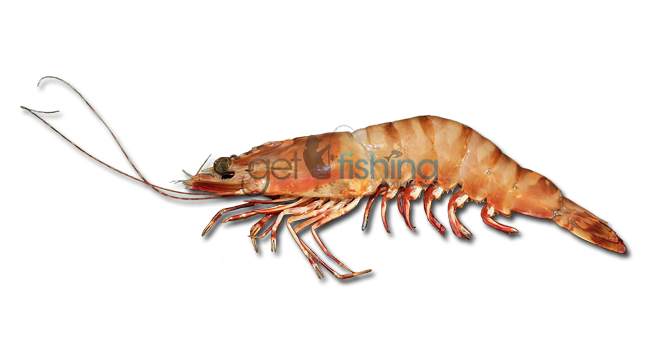Species ID
View AllGrooved Tiger Prawn

Grooved tiger prawns are a large-growing tropical to subtropical species. They have a pale brown to green-brown body with distinct white stripes or saddles along the top of the head, body and tail. The rostrum, or head spike, extends to the back edge of the carapace and has two or three teeth on the under side. Grooved tiger prawns are a bottom-dwelling marine invertebrate that spend much of their time buried in sediment on the sea floor, emerging for feeding, moulting and reproducing. They have a head (carapace), tail, 5 pairs of swimming legs, 5 pairs of walking legs (the front 3 pairs of which have claws) and many pairs of head appendages. They have an external skeleton or shell made from calcium carbonate and chitin, which they must shed so they can grow.
Other names
Flower Prawn, Northern Tiger Prawn, Green Tiger Prawn, Bamboo Node Prawn, Fa Ha
Common size
11-20cm
Related species
Eastern king prawn (Melicertus plebejus), Western king prawn (Penaeus latisulcatus), Red spot king prawn (Melicertus longistylus), Brown tiger prawn (Penaeus esculentus), Black tiger prawn (Penaeus monodon), Red-legged banana prawn (Penaeus indicus), White banana prawn (Penaeus merguiensis)
Lifespan
1-2 years
Habitat
Juvenile Tiger prawns prefer shallow inshore waters with a sand or muddy substrate. They grow up in protected nursery environments such as seagrass beds and move to deeper offshore waters as they grow.
Reproduction
Grooved tiger prawns are bisexual, with females growing larger than males. They mate in offshore waters where males, which must be hard-shelled at the time, insert a sperm capsule into the soft, newly moulted females. The female uses this sperm capsule to fertilise the eggs internally, before releasing the fertilised eggs into the water column some time after. They can spawn more than once per year, depending on water temperature, and females will produce hundreds of thousands of eggs during each event.
Diet
Grooved tiger prawns feed actively day and night. The diet of prawns varies slightly between species but in general they feed on decaying organic matter, plant material, micro-organisms, and invertebrates such as worms and small shellfish.
Buying tips
Prawns should always be eaten fresh, and if not, could pose as a health threat. When purchasing prawns steer clear of those with an unnatural slimy look or blackening to the head, legs and tail. This usually indicates they are old and no longer fresh. Fresh prawns will be evenly coloured, have a slight shine and smell fresh like the ocean. Make sure the heads and shells look firmly connected and intact.
Cooked prawns taste better when boiled in natural saltwater but in some parts of the country, due to bacterial health risks, it is illegal for professional fisherman to cook prawns in natural salt water. If you’re curious to know how they were cooked ask your local seafood retailer when purchasing.
Information courtesy of Department of Fisheries WA and DAFF QLD.
Grooved tiger prawns are found in tropical waters from northern NSW northwards to Shark Bay in WA.
Tiger prawns are a medium to large-sized prawn with a firmer texture. Their red stripes make them attractive in dishes when cooked whole. Tiger prawns are quite tasty simply eaten boiled with a seasoning of salt and perhaps dipped in seafood sauce, but their firmer texture also makes them perfect for soups and sashimi.
- Is a member of the family Penaeidae (penaeid prawns)
- Closely related to the Brown Tiger Prawn Penaeus esculentus
- Live for 1-2 years
- The current Australian annual commercial catch of Tiger prawns combined is between 3000-5000 tonnes





























